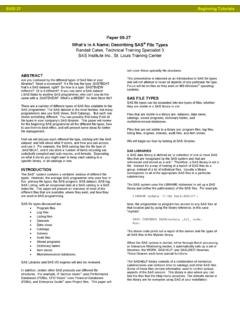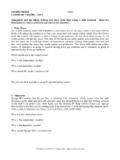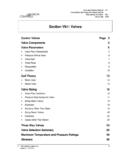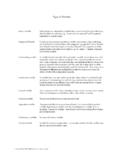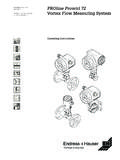Transcription of 130-30: SAS® Macro Variables and Simple Macro …
1 1 Paper 130-30 SAS Macro Variables and Simple Macro ProgramsSteven First, Katie Ronk, Systems Seminar Consultants, Madison, WIABSTRACTSAS macros can be a wonderful extension of the SAS language. This hands-on-workshop will introduce SAS usersto SAS Macro Variables and Simple Macro programs . Please note that due to time constraints it will be only SAS programming language has a rich toolbox of features that can offer a lot of power to the user. Usingmacro Variables and Macro code is difficult to learn without some training and examples that are easy to workshop will introduce the user to a few of the very powerful techniques that are possible using macrovariables and Macro of the topics to be covered include: What is a Macro ? What is a Macro variable and what does it do? Examples of some of the standard SAS Macro Variables How the SAS Macro processor handles Macro Variables Passing information to other steps in a program using Macro Variables Creating and invoking Macro code How to conditionally run SAS steps based on the logic in your programOBJECTIVES:After completing this class students will: understand how the Macro system fits with the rest of SAS software use system (automatic) Macro Variables create and use user defined Macro Variables define Simple macros pass data from the data step to the Macro Macro OVERVIEWSAS macros construct input for the SAS compiler.
2 Some functions of the SAS Macro processor are to passsymbolic values between SAS statements and steps, to establish default symbolic values, to conditionally executeSAS steps, and to invoke very long, complex code in a quick, short way. It should be noted that the macroprocessor is the SAS system module that processes macros and the SAS Macro languages is how youcommunicate with the macros it is not easy to substitute variable text in statements such as TITLEs, to communicate across SASsteps,to establish default values, and to conditionally execute SAS step. Macros can do this and also hide complex codethat can be invoked macros, SAS programs are DATA and PROC steps that are scanned one statement at a time looking forthebeginning of step (step boundary). When the beginning of step is found, all statements in the step are compiled andthis continues until when the end of step is found (the next step boundary), the previous step WorkshopsSUGI30 2 SAS step boundaries are the SAS keywords:DATA ENDSASPROC LINESCARDS LINES4 CARDS4 PARMCARDSDATALINES QUITDATALINES4 RUNThe RUN statement, while not an explicit step boundary, acts as an explicit step boundary in most PROCs to startexecution immediately.
3 The use of RUN after each step is highly recommended as shown by the saleexps; <--Step, start compile infile rawin; input name $1-10 division $12 years 15-16 sales 19-25 expense 27-34; run; <--Step end, exec previousproc print data=saleexps; <--Step start, start compile run; <--Step end, exec previousproc means data=saleexps; var sales expense; run; <--Step end, exec previousTHE SAS Macro LANGUAGEThe SAS Macro language is a second SAS programming language imbedded in SAS code that manipulatesstrings. Characteristics of this language are: strings are sequences of characters all input to the Macro language is a string usually strings are SAS code, but don't need to be the Macro processor manipulates strings and may send them back for LANGUAGE COMPONENTSThe Macro language has several kinds of Macro Variables : are used to store and manipulate character strings follow SAS naming rules are NOT the same as DATA step Variables are stored in memory in a Macro symbol Macro statements: begin with a % and a Macro keyword and end with semicolon (;) assign values, substitute values, and change Macro Variables can branch or generate SAS statements PROCESSOR FLOWM acro statements are given to the Macro processor BEFORE the special triggers direct action by the Macro processor.
4 The percent sign (%.) may signify the start of amacro statement and Macro Variables are referred to with &. These characters might, however, be used forother purposes in text and may not be intended to do anything with the Macro systemHands-on WorkshopsSUGI30 3A Macro PROBLEMS uppose you would like to have the day of week and current date appear in a title, but SAS titles are text, notvariables. A possible solution might be to use some automatic system Macro PRINT DATA=DEPTSALE; TITLE "Department Sales as of &SYSDAY TITLE2 "Deliver to Michael O Malley";RUN;Automatic Macro VariablesBelow is a partial list of automatic Macro Variables and their usage:SYSBUFFR text entered in response to %INPUTSYSCMD last non-SAS command enteredSYSDATE current date in DATE6. or DATE7. formatSYSDAY current day of the weekSYSDEVIC current graphics deviceSYSDSN last SAS dataset built ( ,WORK SOFTSALE)SYSENV SAS environment (FORE or BACK)SYSERR return code set by SAS proceduresSYSFILRC whether last FILENAME executed correctlySYSINDEX number of macros started in jobSYSINFO system information given by some PROCSSYSJOBID name of executing job or userSYSLAST last SAS dataset built ( , )
5 SYSLIBRC return code from last LIBNAME statementSYSLCKRC whether most recent lock was successfulSYSMENV Macro execution environmentSYSMSG message displayed with %DISPLAYSYSPARM value passed from SYSPARM in JCLSYSPROD indicates whether a SAS product is licensedSYSPBUFF all Macro parameters passedSYSRC return code from Macro processorSYSSCP operating system where SAS is runningSYSTIME starting time of jobSYSVER SAS versionAny of these Variables can be used anywhere appropriate in SAS. Again, if quoted use the double quotecharacter if resolution is example:FOOTNOTE "THIS REPORT WAS RUN ON &SYSDAY, Resolves to:FOOTNOTE "THIS REPORT WAS RUN ON FRIDAY, 25 MAR05";Hands-on WorkshopsSUGI30 4 Displaying Macro Variables %PUT displays Macro Variables to the log at compile time. There is no column control as in the DATA StepPUT statement, and quotes are not required. %PUT can display text, Macro Variables , or a few specialvariables such as _all_ which displays all Macro Variables .
6 %PUT is often the easiest way to debug :DATA NEWPAY; INFILE DD1; INPUT EMP$ RATE;RUN;%PUT ** &SYSDATE **;Partial SAS Log:** 25 MAR05 **Displaying All Macro Variables %PUT can display all current Macro Variables by specifying :%PUT _ALL_;Partial SAS Log:GLOBAL MBILLYR 99 GLOBAL SSCDEV CAUTOMATIC AFDSID 0 AUTOMATIC AFDSNAMEAUTOMATIC AFLIBAUTOMATIC AFSTR1 AUTOMATIC AFSTR2 AUTOMATIC FSPBDVAUTOMATIC SYSBUFFRAUTOMATIC SYSCMDAUTOMATIC SYSDATE 25 MAR05 AUTOMATIC SYSDAY FridayAUTOMATIC SYSDSN _NULL_AUTOMATIC SYSENV FOREAUTOMATIC SYSERR 0 AUTOMATIC SYSFILRC 0 AUTOMATIC SYSINDEX 1 AUTOMATIC SYSINFO 0 AUTOMATIC SYSJOBID 0000016959 AUTOMATIC SYSLAST _NULL_AUTOMATIC SYSMSGAUTOMATIC SYSPARMAUTOMATIC SYSRC 0 AUTOMATIC SYSSCP WINAUTOMATIC SYSSCPL WIN_32 SAUTOMATIC SYSSITE 0011485002 AUTOMATIC SYSTIME 10:35 AUTOMATIC SYSVER SYSVLONG WorkshopsSUGI30 5 User Defined Macro VariablesProblem: You reference a SAS datasetname several times in a SAS PAYROLL; INPUT EMP$ RATE; DATALINES;TOM 10 JIM 10;PROC PRINT DATA=PAYROLL; TITLE "PRINT OF DATASET PAYROLL";RUN;Question: How can you change the name quickly in one place only AND have the datasetname appear in atitle?
7 Solution: Use a Macro variable . You can define Macro Variables with %LET. You refer to the Variables later with & variable . Macro will substitute value for all occurrences of & :%LET variable =value;%LET NAME=PAYROLL;DATA INPUT EMP$ RATE; DATALINES;TOM 10 JIM 10;PROC PRINT DATA= TITLE "PRINT OF DATASET RUN;The Generated SAS CodeDATA PAYROLL; INPUT EMP$ RATE; DATALINES;TOM 10 JIM 10;PROC PRINT DATA=PAYROLL; TITLE "PRINT OF DATASET PAYROLL";RUN;To later assign a new value, use another %LET to assign a different NAME=NEWPAY;DATA INPUT EMP$ RATE; DATALINES;TOM 10 JIM 10;PROC PRINT DATA= TITLE "PRINT OF DATASET RUN;Hands-on WorkshopsSUGI30 6 The Generated SAS CodeDATA NEWPAY; INPUT EMP$ RATE;DATALINES; TOM 10 JIM 10;PROC PRINT DATA=NEWPAY;TITLE "PRINT OF DATASET NEWPAY";RUN;Assigning SAS StatementsTo include special characters including semicolon, SAS statements etc, %STR allows you to enclose specialcharacters within NAME=NEWPAY;%LET CHART=%STR(PROC CHART;VBAR EMP;RUN;);DATA INPUT EMP$ RATE; DATALINES;TOM 10 JIM 10.
8 &CHARTPROC PRINT DATA= TITLE "PRINT OF DATASET RUN;The Generated SAS CodeDATA NEWPAY; INPUT EMP$ RATE; DATALINES;TOM 10 JIM 10;PROC CHART;VBAR EMP;RUN;PROC PRINT DATA=NEWPAY; TITLE "PRINT OF DATASET NEWPAY";RUN;Nesting of Macro VariablesMacro Variables can contain other Macro NAME=NEWPAY;%LET CHART=%STR(PROC CHART DATA= VBAR EMP;RUN;);DATA INPUT EMP$ RATE; DATALINES;TOM 10 JIM 10;&CHARTPROC PRINT DATA= TITLE "PRINT OF DATASET RUN;Hands-on WorkshopsSUGI30 7 The Generated SAS CodeDATA NEWPAY; INPUT EMP$ RATE; DATALINES;TOM 10 JIM 10;PROC CHART DATA=NEWPAY;VBAR EMP;RUN;PROC PRINT DATA=NEWPAY; TITLE "PRINT OF DATASET NEWPAY";RUN;Other Macro Debugging OptionsSAS gives several options that control log output at various points in the compilation and execution of yourSAS program. SYMBOLGEN/NOSYMBOLGEN controls display of variable resolution MPRINT/NOMPRINT displays generated statements given to the compiler MLOGIC/NOMLOGIC displays tracing information during Macro MacrosStored text including logic that can be inserted anywhere in a SAS program and can include: constants such as literals, Variables , names, and statements assignments to Macro Variables Macro programming statements Macro language functions invocations of other functions nested Macro definitions LOGIC to conditionally generate SAS and Using Macros ( Macro programs )% Macro and %MEND define macros, %macroname will invoke it : Define a Macro to run PROC CHART and later invoke CHART; PROC CHART DATA= VBAR EMP;RUN;%MEND;%LET NAME=NEWPAY;DATA INPUT EMP$ RATE; DATALINES;TOM 10 JIM 10;RUN;%CHARTPROC PRINT DATA= TITLE "PRINT OF DATASET RUN.
9 Hands-on WorkshopsSUGI30 8 The Generated CodeDATA NEWPAY; INPUT EMP$ RATE; DATALINES;TOM 10 JIM 10;RUN;PROC CHART DATA=NEWPAY; VBAR EMP;RUN;PROC PRINT DATA=NEWPAY; TITLE "PRINT OF DATASET NEWPAY";RUN;Positional Macro ParametersPositional Macro parameters are defined in order after the Macro name. Values for those parameters can beset when the Macro is invoked. Keyword parameters are also allowed, and can set default CHART(NAME,BARVAR); PROC CHART DATA= VBAR RUN;%MEND;%CHART(PAYROLL,EMP)Resolves to:PROC CHART DATA=PAYROLL; VBAR EMP;RUN;Nested MacrosMacros can call other CHART(NAME,BARVAR); PROC CHART DATA= VBAR RUN;%MEND;% Macro PTCHART(NAME,BARVAR);%CHART(PAYROLL,EMP) PROC PRINT DATA= TITLE "PRINT OF DATASET RUN;%MEND;%PTCHART(PAYROLL,EMP)The Generated SAS CodePROC CHART DATA=PAYROLL; VBAR EMP;RUN;PROC PRINT DATA=PAYROLL; TITLE "PRINT OF DATASET PAYROLL";RUN;Hands-on WorkshopsSUGI30 9 Conditional Macro Compilation%IF can conditionally pass code to the : Run PROC PRINT only if PRTCH= PTCHT(PRTCH,NAME,BARVAR); %IF &PRTCH=YES %THEN PROC PRINT DATA= ; PROC CHART DATA= VBAR RUN;%MEND;%PTCHT(YES,PAYROLL,EMP)The Generated SAS CodePROC PRINT DATA=PAYROLL ;PROC CHART DATA=PAYROLL; VBAR EMP;RUN.
10 The %DO Statement%DO allows many statements to be conditionally : Submit as before, but include PTCHT(PRTCH,NAME,BARVAR); %IF &PRTCH=YES %THEN %DO; PROC PRINT DATA= TITLE "PRINT OF DATASET RUN; END; PROC CHART DATA= VBAR RUN;%MEND;%PTCHT(YES,PAYROLL,EMP)The Generated SAS CodePROC PRINT DATA=PAYROLL; TITLE "PRINT OF DATASET PAYROLL";RUN;PROC CHART DATA=PAYROLL; VBAR EMP;RUN;Hands-on WorkshopsSUGI30 10 Iterative Macro Invocation%DO can also vary a : Run PROC PRINT &PRTNUM PRTMAC(PRTNUM,NAME); %DO I= 1 %TO PROC PRINT DATA= TITLE "PRINT OF DATASET RUN; %END;%MEND;%PRTMAC(4,PAYROLL)The Generated SAS CodePROC PRINT DATA=PAYROLL1; TITLE "PRINT OF DATASET PAYROLL1";RUN;PROC PRINT DATA=PAYROLL2; TITLE "PRINT OF DATASET PAYROLL2";RUN;PROC PRINT DATA=PAYROLL3; TITLE "PRINT OF DATASET PAYROLL3";RUN;PROC PRINT DATA=PAYROLL4; TITLE "PRINT OF DATASET PAYROLL4";RUN;SAS DATA Step InterfacesSYMGET, SYMPUT, and Macro Variables can transfer values between SAS steps.









